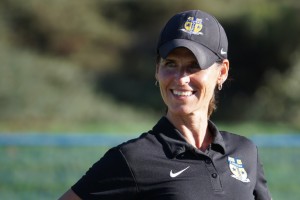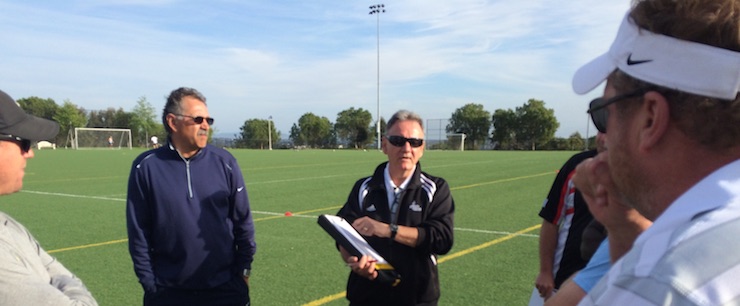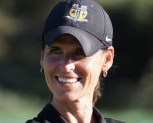Carrie Taylor Talks To Dr. Ron Quinn
Who trains the coaches who train our youth players? What do coaches need to know to develop our youth players? Dr. Ron Quinn knows and he developed the National Youth License Course that Directors of Coaching from around the nation take. Discover what he believes is important when developing youth soccer players.
In 1995 a group of soccer professionals were posed with the question of what type of coach licensing exists for players U12 and younger?
Those gentlemen asked were Dr. Tom Fleck, Dr. Ron Quinn, Dr. David Carr, Bill Buren, Dave Simeone, and Virgil Stringfield. These coaches drafted the first coaching education program that took a child development approach. The National Youth License motto is “The Game in the Child”, and it is based on the belief that you can’t teach a six-year old how to play soccer until you first learn how to teach a six-year old. One of the authors of the NYL, Dr. Ron Quinn, was recently interviewed to give us some more insight into the National Youth License.
Carrie Taylor: What are the three types of child development that the NYL focuses on and why are they important?
Dr. Quinn: We realized that many coaches were expecting 6-12 year olds to train like mini-adults. That is not the way to educate children, so we introduced child development theories that addressed their cognitive (mental), psychomotor (movement), and psychosocial (social) development at the various age groups (U6,8, 10, &12). This allowed for coaches to better understand the complete child and how nothing happens in isolation, meaning you can’t teach dribbling (psychomotor) without also taking into consideration their cognitive (how they process information) stage and their social/emotional needs.

Carrie Taylor: What are the principles of youth coaching and educational theories that are the foundation for National Youth License?
Dr. Quinn: The six basic principles are:
- Developmentally Appropriate Activities
- Clear, Concise and Correct Information
- Simple to Complex
- Safe and Appropriate Training Area
- Decision Making
- Implications for the Game
In addition to the above principles, the NYL teaching method takes theory and puts it right into practice through designing and selecting developmentally appropriate activities that utilize Mosston’s Slanty- Line and Torbert’s Expansion, Equalization and Interactive Challenges. The Slanty-Line concept is the belief that most games are games of elimination, which eliminate the child who needs the most practice. Essentially presenting activities that assumed everyone was at the same level (a straight line approach). The Slanty-Line works under the assumption that activities can be designed that allow for kids of different ability levels to participate at their level and when they feel ready, that the risk of failure or elimination is reduced, the child will seek a higher challenge. Similarly, Dr. Marianne Torbert of Temple University believed that human movement was a tool for human development. Through a humanistic approach to physical education developed the concepts of Expansion-how can we design activities that increase participation and the use of equipment, i.e., every child with a ball; Equalization-included the notion that every child should have an equal opportunity for success, not just the bigger, faster, stronger; and Interactive Challenges-challenges all of us to recognize that on any team you will have a wide range of ability levels and success will depend on the coaches ability to provide activities that allow for all players to interact in a positive and growth enhancing manner.
These two concepts provide the foundation of the NYL philosophy that then employs problem-solving and discovery methodologies.
Carrie Taylor: Each day in the course is devoted to a different age group (u6,8,10, 12). Why is this important to make these age groupings?
 Dr. Quinn: Taking into consideration the child centered approach, the delivery of age group instruction on each day provides the coaches the opportunity to see children of that age each day. As a result, the changes, for example from a U6 to U8 are VERY dramatic. In most normal coaching situations, a coach has their own team, and may not be exposed to the age group before or after. The course then provides a real picture of developmental changes that occur over six year in the five day course.
Dr. Quinn: Taking into consideration the child centered approach, the delivery of age group instruction on each day provides the coaches the opportunity to see children of that age each day. As a result, the changes, for example from a U6 to U8 are VERY dramatic. In most normal coaching situations, a coach has their own team, and may not be exposed to the age group before or after. The course then provides a real picture of developmental changes that occur over six year in the five day course.
Carrie Taylor: What type of coach should take this course? Only those working with the younger ages or is it for all levels of coaches?
Dr. Quinn: We believe that coaches of all age groups and levels would find this course worthwhile, because of its strong connection to the teaching process. Coaches who take this course have stated that it has made them better teacher of, not only the game, but of children.
Carrie Taylor: Any other things you might want to highlight about the course?
Dr. Quinn: We are continuing to study the NYL and will begin to collect data on how players under NYL coaches are developing and learning the game. Anyone who would like to send me their observations regarding how the players approach practice and games as a result of the NYL methodologies, can contact me at Quinnr@xavier.edu Are they better handling the ball, how do they deal with pressure, do they make better decisions, has the Game in the Child begun to come out?






